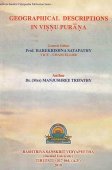Kulaparvata, Kula-parvata: 12 definitions
Introduction:
Kulaparvata means something in Hinduism, Sanskrit, Marathi. If you want to know the exact meaning, history, etymology or English translation of this term then check out the descriptions on this page. Add your comment or reference to a book if you want to contribute to this summary article.
In Hinduism
Purana and Itihasa (epic history)
Source: Wisdom Library: PurāṇasKulaparvata (कुलपर्वत) literally translates to “mountain associated with a certain tribe”. It is a term used in the purāṇas to categorize the various mountains according to their functional significance.
Source: archive.org: Geography in Ancient Indian inscriptions (purāṇa)Kulaparvata (कुलपर्वत) refers to “group mountain” or “clan mountain”.—Every varṣa has seven principal ranges styled kulaparvata besides a number of small hills (kṣudraparvata) which are situated near these. Mahendra, Malaya, Sahya, Śuktimān, Ṛkṣa, Vindhya and Pāripātra are the names of the kulaparvatas of Bhāratavarṣa given in the great Epic and the Purāṇas. These kulaparvatas are associated with a distinct country or tribe.
Source: Cologne Digital Sanskrit Dictionaries: The Purana IndexKulaparvata (कुलपर्वत).—Seven in number.*
- * Matsya-purāṇa 114. 17.

The Purana (पुराण, purāṇas) refers to Sanskrit literature preserving ancient India’s vast cultural history, including historical legends, religious ceremonies, various arts and sciences. The eighteen mahapuranas total over 400,000 shlokas (metrical couplets) and date to at least several centuries BCE.
Kavya (poetry)
Source: Shodhganga: A critical appreciation of soddhalas udayasundarikathaKulaparvata (कुलपर्वत).—Soḍḍhala has also referred to kulaparvatas and according to him they are eight in number. Usually kulaparvatas are said to he seven as is shown hy Rājaśekhara in the Kāvyamīmāṃsa and hy the Purāṇas.
They are
- Vindhya,
- Pāriyātra,
- Śuktiman,
- Ṛkṣa (Ṛkṣavān),
- Mahendra,
- Sahya
- and Malaya.
Soḍḍhala has added one more to this list, namely Kanyācala.

Kavya (काव्य, kavya) refers to Sanskrit poetry, a popular ancient Indian tradition of literature. There have been many Sanskrit poets over the ages, hailing from ancient India and beyond. This topic includes mahakavya, or ‘epic poetry’ and natya, or ‘dramatic poetry’.
Languages of India and abroad
Marathi-English dictionary
Source: DDSA: The Molesworth Marathi and English Dictionarykulaparvata (कुलपर्वत).—m pl (S) See kulācala & saptaparvata.
--- OR ---
kūḷaparvata (कूळपर्वत).—m (Poetry.) See kulācala & saptaparvata.
Marathi is an Indo-European language having over 70 million native speakers people in (predominantly) Maharashtra India. Marathi, like many other Indo-Aryan languages, evolved from early forms of Prakrit, which itself is a subset of Sanskrit, one of the most ancient languages of the world.
Sanskrit dictionary
Source: DDSA: The practical Sanskrit-English dictionaryKulaparvata (कुलपर्वत).—a principal mountain, one of a class of seven mountains which are supposed to exist in each division of the continent; their names are :-महेन्द्रो मलयः सह्यः शुक्तिमान् ऋक्षपर्वतः । विन्ध्यश्च पारियात्रश्च सप्तैते कुलपर्वताः (mahendro malayaḥ sahyaḥ śuktimān ṛkṣaparvataḥ | vindhyaśca pāriyātraśca saptaite kulaparvatāḥ) ||
Derivable forms: kulaparvataḥ (कुलपर्वतः).
Kulaparvata is a Sanskrit compound consisting of the terms kula and parvata (पर्वत). See also (synonyms): kulācala, kulādri, kulaśaila.
--- OR ---
Kulaparvata (कुलपर्वत).—see कुलाचल (kulācala) above.
Derivable forms: kulaparvataḥ (कुलपर्वतः).
Kulaparvata is a Sanskrit compound consisting of the terms kula and parvata (पर्वत). See also (synonyms): kulaśaila.
Source: Cologne Digital Sanskrit Dictionaries: Shabda-Sagara Sanskrit-English DictionaryKulaparvata (कुलपर्वत) or Kulaparvvata.—m.
(-taḥ) A principal mountain of India, any one of seven so considered: see kulācala. E. kula, and parvata a mountain; also similar compounds, as kulagiri, kulaśaila, &c.
Source: Cologne Digital Sanskrit Dictionaries: Monier-Williams Sanskrit-English DictionaryKulaparvata (कुलपर्वत):—[=kula-parvata] [from kula] m. = -giri q.v.
Source: Cologne Digital Sanskrit Dictionaries: Yates Sanskrit-English DictionaryKulaparvata (कुलपर्वत):—[kula-parvata] (taḥ) 1. m. Any one of the seven Indian mountains.
[Sanskrit to German]
Sanskrit, also spelled संस्कृतम् (saṃskṛtam), is an ancient language of India commonly seen as the grandmother of the Indo-European language family (even English!). Closely allied with Prakrit and Pali, Sanskrit is more exhaustive in both grammar and terms and has the most extensive collection of literature in the world, greatly surpassing its sister-languages Greek and Latin.
Kannada-English dictionary
Source: Alar: Kannada-English corpusKulaparvata (ಕುಲಪರ್ವತ):—[noun] = ಕುಲಗಿರಿ [kulagiri].
Kannada is a Dravidian language (as opposed to the Indo-European language family) mainly spoken in the southwestern region of India.
See also (Relevant definitions)
Partial matches: Parvata, Kula.
Full-text (+108): Pariyatra, Shuktiman, Vindhya, Mahendra, Kulacala, Sahya, Malaya, Rikshavan, Shuktimat, Kuladri, Kanyacala, Kulashikharin, Varnamalagra, Ashoka, Hariparvata, Shvetavarna, Koranja, Suryakanta, Vidyutvanta, Rikshavanta.
Relevant text
Search found 13 books and stories containing Kulaparvata, Kula-parvata, Kūḷaparvata, Kūlaparvata; (plurals include: Kulaparvatas, parvatas, Kūḷaparvatas, Kūlaparvatas). You can also click to the full overview containing English textual excerpts. Below are direct links for the most relevant articles:
The Brahma Purana (by G. P. Bhatt)
The Linga Purana (by J. L. Shastri)
Chapter 53 - Geography of the World < [Section 1 - Uttarabhāga]
The Matsya Purana (critical study) (by Kushal Kalita)
Part 2 - Rivers and Mountains of Bhāratavarṣa < [Chapter 8 - Geographical data in the Matsyapurāṇa]
Geographical Aspects of the Purāṇas (Introduction) < [Chapter 8 - Geographical data in the Matsyapurāṇa]
The Shiva Purana (by J. L. Shastri)
Chapter 18 - The greatness of the Jyotirliṅga Oṃkāreśvara < [Section 4 - Koṭirudra-Saṃhitā]
Chapter 18 - Seven continents (varṣa) < [Section 5 - Umā-Saṃhitā]
Chapter 5 - Binduga’s salvation < [Śivapurāṇa-māhātmya]
The Skanda Purana (by G. V. Tagare)
Chapter 33 - Greatness of Agastya’s Hermitage < [Section 1 - Tīrtha-māhātmya]
Chapter 7 - The Advent of Kūrma Kalpa < [Section 3 - Revā-khaṇḍa]
Chapter 6 - Epithets of Narmadā Explained < [Section 3 - Revā-khaṇḍa]
Rivers in Ancient India (study) (by Archana Sarma)
11. Descriptions of the rivers in the Jambudvīpa < [Chapter 5 - Rivers in the Purāṇic Literature]
Related products

